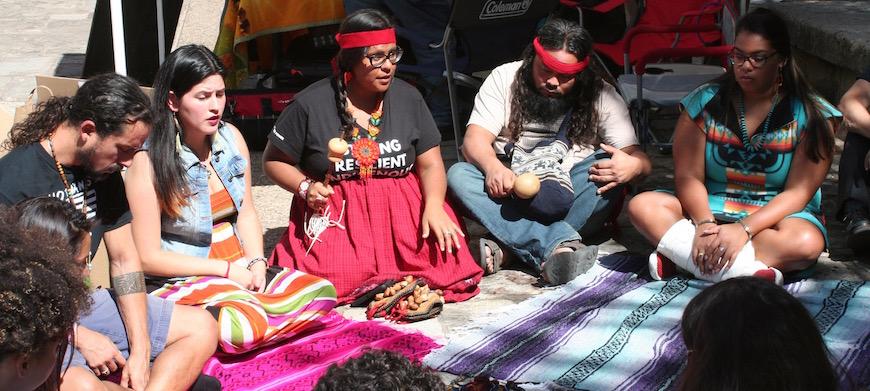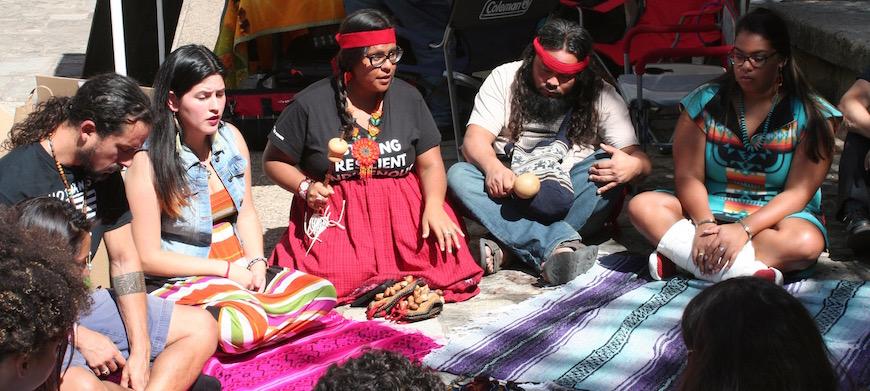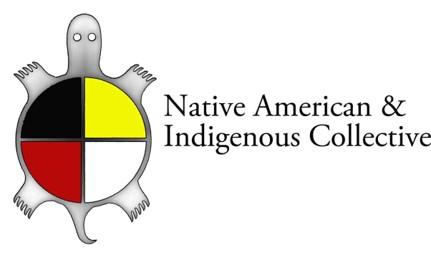Photo courtesy of Native American Indigenous Studies at the University of Texas at Austin
A reflection on the invisibility and erasure of indigenous peoples on campus and across the United States. Due to the complex and troubled history of terminology, the term “indigenous” will be used outside of direct dialogue and organizational names.
Story by William Gonzales
For indigenous students, invisibility has been a pervasive issue. The fight against invisibility and erasure, and the lack of representation for indigenous students, are constant struggles, according to Ángela Lorena Vela Arce of the Dolores de Las Minas community in South Texas. Arce works as the director of operations of the the Native American and Indigenous Collective (NAIC) at the University of Texas at Austin.
Photo courtesy of the Multicultural Engagement Center
To get the same resources or recognition as other communities on campus, Arce says that the NAIC has to work twice as hard. “A lot of work is done by the students,” Arce says. “Our self-representation is excellent. We’re very engaged in our communities, yet we don’t receive much support from administration.”
Arce says the lack of campus recognition doesn’t end there. “We don’t have a space to convene. There aren’t accessible spaces for practicing our traditions and faiths. We’re not allowed to have open flames, so we can’t even burn sage,” says Arce. On top of that, Arce says that getting reservations for their activities is difficult, because they often find themselves competing with other students for space.
Arce also points out that her indigenous identity can make relationships with professors tense at times. She recounts instances at school when professors blatantly disrespected indigenous cultures and traditions. “One professor in particular was disrespecting languages,” Arce says. “Other problems have revolved around the interest or curiosity about indigenous peoples. We often get approached in an invasive way.”
Additionally, Arce notes that professors often have difficulty understanding the concept of de-colonial knowledge, a concept that many aren’t aware of. Decolonization takes on many forms and definitions, but for many indigenous folk, it is often defined as a journey of healing and privileging indigenous frameworks of thought. Arce defines decolonization as “resisting against historical and contemporary colonialism, and making space for native and indigenous folks to exercise self-determination, as well as individual and communal healing.”
The issue of recognition and identification has shown itself to be a factor in the symbolic annihilation of indigenous peoples. According to UT demographics, only 0.4 percent of the student body is indigenous, but Arce says that number could be vastly different as many don’t identify with their indigenous ancestry for a variety of reasons, including protection from discrimination.
“We’ve been conditioned to hide our indigeneity,” Arce says. “It’s been a means of survival. History has shown that it can be criminal or deviant to be indigenous.” Arce also emphasized the concept of what the Indigenous Cultures Institute of San Marcos calls “detribalization,” the removal of one’s self from their community, kin, landscape, and nation or nation-tribe, often due to displacement. “We’ve been forcibly distanced from our peoples. But when we’re organized under Indigenous frameworks, we resist man-made borders,” Arce says.
Indigenous identification is further complicated due to the United States’ Blood Quantum Laws, which define the authenticity of being indigenous by blood. Whereas many indigenous peoples recognize their own kin as part of their community and culture, blood quantum is a colonial construct.
Some people who are native, but not recognized as so, often remain confused about who they really are. Arce says that one has to trust their history, oral stories and the words of their family and elders. “People get very self-conscious because they often feel that they need a document to prove who they are. It is often said that ‘dogs, Indians, and horses’ are the only beings that have their blood measured by the US government, defined as the percentage of their ancestors out of their total ancestors, who are documented as full-blood indigenous Americans,” says Arce. “We continue to have other ways of recognizing each other as indigenous kin regardless of policy.”
Interactions on campus outside of the classroom setting are often reflective of history. People are taught tropes about indigenous peoples from a young age. “In mainstream society, we’re still caricatures,” she says. She has even had people approach her while tabling asking if she was selling sage when there was no sage present nor any sign that it was being sold.
Arce also says that people tend to lump all indigenous peoples together. “There are over 700 sovereign nations and communities here on Turtle Island — North America — as well as many other indigenous peoples from around the world. It doesn’t make sense to assume that one indigenous person knows everything about all indigenous peoples.”
Despite the drowning out of indigenous voices on campus, support can still be found. Arce cites numerous minority communities and university departments as allies of indigenous students. Resources for students include the Native American and Indigenous Studies program (NAIS) and The Native American and Indigenous Collective (NAIC), as well as off-campus resources such as the Native American and Indigenous Peoples Association, Resistencia Bookstore, The Puerto Rican Cultural Center, Great Promise for American Indians and the Indigenous Cultures Institute of San Marcos, many of which maintain close relationships with UT and Central Texas communities.
“We’ve struggled because we don’t have as many resources as others. But one’s indigeneity, the connection to a homeland and a people, never truly goes away.” Arce says, adding a quote from a friend. “Your indigeneity and who you truly are can never be erased. You’re not re-learning. You’re remembering.”
Photo courtesy of NAIC
With the help of the aforementioned organizations, The Native American and Indigenous Collective will be hosting their Decolonizing Education Symposium on Apr. 27 and their ninth annual Spring Powwow on Apr. 28.















































Aidan M • May 27, 2018 at 5:06 am
What a well written article